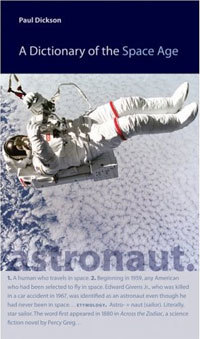Review: A Dictionary of the Space Ageby Jeff Foust
|
| The term “spaceport” has origins predating the beginning of the Space Age: to of all places, an exhibit designed by Willy Ley in the now-defunct Gimbels department store in Manhattan in 1951. |
Dickson describes this book as “simultaneously a revision, an expansion, and a large-scale updating” of a 1976 NASA publication, Origin of NASA Names. This means not only terms that have entered into use in the last three-plus decades, but also words and acronyms from the US military and, to a lesser extent, other countries. Dickson includes both official terminology (including, not surprisingly, a lot of acronyms and their expansions) but also some the slang that became associated with spaceflight, particularly in the early years of the Space Age, whether it was invented then (“A-OK”) or simply adopted and popularized by it (“copacetic” and “tickety-boo”).
Dickson goes beyond the definitions of the words, though, to examine their etymology. For example, “spaceport” has origins predating the beginning of the Space Age: to of all places, an exhibit designed by Willy Ley in the now-defunct Gimbels department store in Manhattan in 1951. Meanwhile, the Franco-German “Symphonie” communications satellites launched in the early 1970s got their name in part because the French foreign minister who helped negotiate the agreement for the satellite program, Maurice Schumann, had a name that reminded another participant in the negotiations of composer Robert Schumann.
A Dictionary of the Space Age is not a comprehensive dictionary, nor does it attempt to be: Dickson, in the introduction, calls it “prismatic” in that it “attempts to cover the most important terms” in much the same way a common dictionary includes only a subset of the words found in an unabridged volume. That means you’ll find some omissions (for example, there is no entry for the Columbia Accident Investigation Board, or CAIB, although there is one for the Challenger Commission), but also some more obscure terms perhaps in less common use today in the space field (“ivory tower”, which the discussion describes as simply a vertical test stand.)
This book comes at a time when the concept of a printed dictionary is beginning to look a little bit archaic. Thanks to the Internet, or even the software built into common operating systems, looking up the definition of a word requires only a few taps on the keyboard. The effort required to research and compile dictionaries on specialty topics like space (or baseball) gets lost, or is at least underappreciated, when the right answer—or at least an acceptable, if incomplete, answer—is freely available. (For example, the dictionary built into the version of MacOS on my computer provided very basic definitions for the words mentioned in the second paragraph above, but without the etymology or the detail, particularly as relevant to space, as provided by Dickson.) For most people that lack of detail isn’t important, but for those seeking to understand both the definitions of many commonly-used words in the space field, as well as the origins, A Dictionary of the Space Age makes for a good investment.
